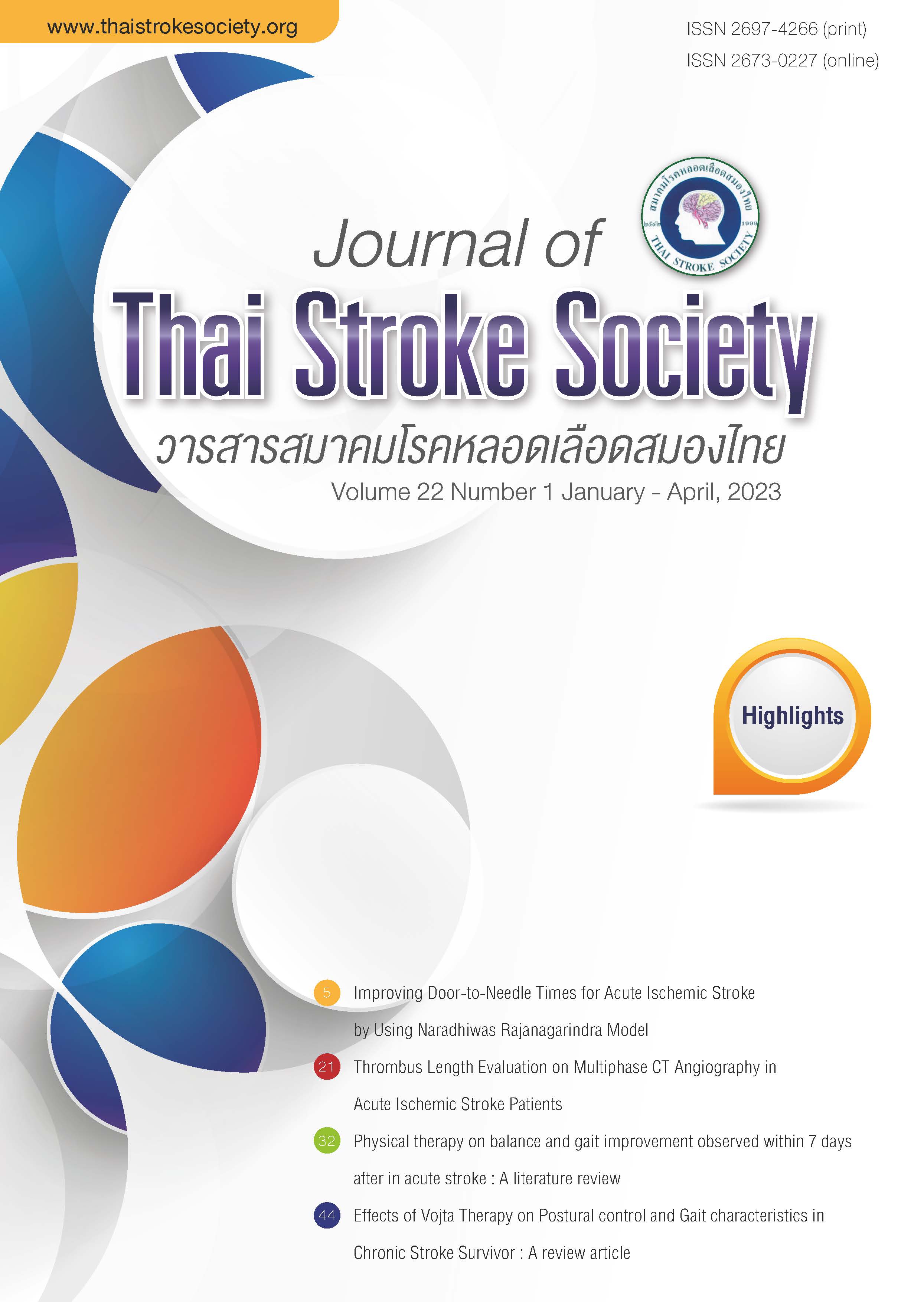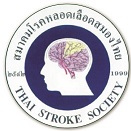วอยตาบำบัดในการดูแลผู้ป่วยโรคหลอดเลือดสมองต่อความสามารถในการทรงท่า และการเดิน: การทบทวนวรรณกรรม
คำสำคัญ:
วอยตาบำบัด, โรคหลอดเลือดสมอง, การควบคุมการทรงท่า, การเดินบทคัดย่อ
วอยตาบำบัดเป็นเทคนิคการรักษาทางกายภาพบำบัดที่อาศัยหลักการการกระตุ้นการทำงานของระบบประสาทสรีรวิทยาด้วยรีเฟล็กซ์โลโคโมชั่น (reflex locomotion) การกระตุ้นด้วยวอยตาอาศัยการจัดท่าทางร่วมกับการให้แรงกดตรงจุดที่จำเพาะ (specific zone) เพื่อกระตุ้นให้เกิดการเคลื่อนไหวแบบรีเฟล็กซ์ จากการศึกษาที่ผ่านมาพบว่าวอยตาบำบัดมีการกระตุ้นการทำงานของสมองส่วนของ supplement motor areas, pre motor areas, superior parietal cortex, และ posterior cingulate cortex จึงมีการใช้วอยตาบำบัดเพื่อรักษาผู้ป่วยโรคหลอดเลือดสมอง โดยพบว่าการรักษาด้วยวอยตาบำบัดช่วยส่งเสริมการทรงท่า การทรงตัว และการเดินในผู้ป่วย อย่างไรก็ตามการศึกษาที่เกี่ยวข้องกับวอยตาบำบัดมีจำนวนไม่มาก เนื่องจากวอยตาบำบัดเป็นเทคนิคจำเพาะที่ต้องได้รับการฝึกฝนและมีข้อห้ามข้อควรระวังในผู้ป่วยกลุ่มนี้
References
Langhorne Peter, Bernhardt Julie and Kwakkel Gert. Stroke rehabilitation. The lancet 2011;377(9778):1693-1702.
Amin Louis. Rehabilitation plan and process in patient after stroke [Bachelor]. Brno: Masaryk University; 2020.
J. Winstein Carolee, Stein Joel, Arena Ross, Bates Barbara, R. Cheney Leora.et al. Guideline for adult stroke rehabilitation and recovery: A Guideline for healthcare processionals from the American heart association/American stroke association. ResearchGate 2016;47:e1-e72. DOI: 10.11161/STR.0000000000000098.
E. Titianova. Hemiparetic gait in stroke neurorehabilitation. ESNCH 2014;10(2):123-130.
Wang Yiji et al. Gait characteristic of post-stroke hemiparetic different walking speeds. Int J Rehabil Res. 2020;43(1):69-75.
Zafeiriou D I. Primitive reflexes and postural reactions in the neurodevelopmental examination. Pediatr Neurol 2004;3:1-8.
Vojta therapy in adulthood information for adults with movement impairments. International Vojta society 2015;3:1-15.
H. Bauer, G. Appaji and D. Mundt. Vojta neurophysiologic therapy. Indian J Pediatr 1992;59:37-51.
รศ. พิมพ์อำไพ เวนเซล. Vojta principle muscle action in reflex movement and motor ontogenesis. Vojta Therapy for adults with mobility difficulties 2nd batch Course A. 31/07/2017-11/08/2017; สถาบันสิรินธร เพื่อการฟื้นฟูสมรรถภาพทางการแพทย์แห่งชาติ. นนทบุรี: มูลนิธิศูนย์สิรินธรเพื่อการฟื้นฟูสมรรถภาพทางการแพทย์แห่งชาติ; 2017. หน้า1-53.
Carratala-Tejada M. et al. Reflex locomotion therapy for balance, gait and fatigue rehabilitation in subjects with multiple sclerosis. J Clin Med 2022;11(567):1-12.
Sanz-Esteban I, et al. Cortical activity during sensorial tractile stimulation in healthy adults through Vojta therapy. A randomized pilot-controlled trial. J NeuroEngineering Rehabil 2021; 18(13):1-13.
Akay T and J Murry A. Relative contribution of proprioceptive and vestibular sensory systems to locomotion: opportunities for discovery in the age of molecular science. Int J Mol Sci 2021; 22(1467):1-18.
Martinek M, Panel D, Novakova T and Pavlu D. Analysis of intracerebral activity during reflex locomotion stimulation according to Vojta’s principle. Appl Sci 2022; 12(14):1-9.
Ha SY and Sung YH. Changes of neural pathway after Vojta approach in a child with Developmental delay. Children 2021; 8(918):1-7.
Lim H and Kim T. Effects of Vojta therapy in gait of children with spastic diplegia. J Phys Ther Sci 2013;25:1605-1608.
Sung YH and Ha SY. The Vojta approach changes thickness of abdominal muscle and gait in children with spastic cerebral palsy: A randomized controlled trial, pilot study. Technol Health Care 2019;13(28):1-9.
Juan-Manuel Belda-Lois, Silvia Mena-del Horno, Ignacio Bermejo-Bosch, Juan C Moreno, Jose L Pons, Dario Farina et al. Rehabilitation of gait after stroke: a review towards a top-down approach. J NeuroEng Rehabil 2011;8(66):1-19.
Lopez P-L et al. The implementation of a reflex locomotion program according to Vojta produces short-term automatic postural control changes in patients with multiple sclerosis. J Bodyw Mov Ther 2021;26:401-405.
Epple C, Maurer-Burkhard B, Lichti MC and Steiner T. Vojta therapy in patient with acute stroke: A new approach in stroke rehabilitation. Phys Med Rehabil Int 2018;5(1):1-5.
Epple C, Maurer-Burhard B, Lichti MC and Steiner T. Vojta therapy improve postural control in very early stroke rehabilitation: a randomized controlled pilot trial. Neurol Res Pract 2020; 2(23):1-11.
Tayati W, Chompunuch N and Wongphaet P. Effect of Vojta therapy on balance and walking of community dwelling chronic stroke patients. ASEAN J Rehabil Med 2020;30(1):21-25.
Rogers M and Martinez K. Recovery and rehabilitation of standing balance after stroke. In: Stein J, Harvey RL, Macko RF, Winstein CJ, Zorowitz RD, editors. Stroke recovery and rehabilitation. 1st ed. New York: Demos medical publishing; 2009. P.343-374.
Hok P and Hlustik P. Modulation of the human sensorimotor system by afferent somatosensory input: evidence from experimental pressure stimulation and physiotherapy. Biomed Pap Med Fac Univ Palacky Olomouc Czech Repub 2020;164:1-9.
กนกวรรณ ติลกสกุลชัย. สรีรวิทยาระบบประสาทส่วนกลาง. ใน: สุพรพิมพ์ เจียสกุล, สุพัตรา โล่ห์สิริวัฒน์ และวัฒนา วัฒนาภา. สรีรวิทยา 3. พิมพ์ครั้งที่ 1. กรุงเทพฯ: เรือนแก้วการพิมพ์; 2544. หน้า 890-1063.
Ha SY and Sung YH. Effects of Vojta method on trunk stability in healthy individuals. JER 2016;12(6):542-547.
Zmf-asia.org [homepage on the Internet]. Thailand: Zy movement foundation Thailand. [update 2021; cited 2022 Mar 26]. Available from: https://www.zmf-asia.org/17518580/vojta-therapy-กดจุดวอยต้า
Downloads
เผยแพร่แล้ว
How to Cite
ฉบับ
บท
License
Copyright (c) 2023 วารสารสมาคมโรคหลอดเลือดสมองไทย

This work is licensed under a Creative Commons Attribution-NonCommercial-NoDerivatives 4.0 International License.
ข้อความภายในบทความที่ตีพิมพ์ในวารสารสมาคมโรคหลอดเลือดสมองไทยเล่มนี้ ตลอดจนความรับผิดชอบด้านเนื้อหาและการตรวจร่างบทความเป็นของผู้นิพนธ์ ไม่เกี่ยวข้องกับกองบรรณาธิการแต่อย่างใด การนำเนื้อหา ข้อความหรือข้อคิดเห็นของบทความไปเผยแพร่ ต้องได้รับอนุญาตจากกองบรรณาธิการอย่างเป็นลายลักษณ์อักษร ผลงานที่ได้รับการตีพิมพ์ในวารสารเล่มนี้ถือเป็นลิขสิทธิ์ของวารสาร




